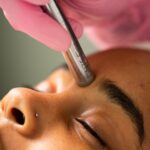More than any other type of skin, dark skins withstand the test of time.
Despite that, old age could take a toll on rich-complexioned skin. The signs are often palpable. The areas of skin around the eyes and the cheeks become hollow. Also, frown lines form in the forehead and the skin around the nasolabial folds, and in the marionette lines begin to crease and sag.
Taut, young skin begins to sag as the collagen and elastic tissue break down.
There are innovative approaches to restore youth into the skin. Injecting hyaluronic acid, fat, collagen, and other substances can add life and fullness to the skin.
Although the use of dermal fillers is common among rich-complexioned men and women, anyone with a skin condition should be cautious before getting fillers. People with keloids, skin inflammation, and infections should avoid fillers.
Fillers should be injected by a dermatologist with experience in treating and maintaining rich complexioned skin. Prior to the injection, the medication that thins blood should be avoided. After injection, no special care needs to be taken. However, areas, where fillers are injected, might look puffed or red.
Different Items can be used as fillers. Some of them include:
Hyaluronic Acid
Hyaluronic Acid occurs in every vertebra. It keeps the skin firm and moisturized.
Hyaluronic Acid fillers are injected into the dermal layer of skin to reinforce the collagen.
The acids are injected alongside the area being treated in small portions after which the injected areas are vigorously massaged to make it smooth and prevent lumps.
Some people report being uncomfortable, so a topical anesthetic can be applied about 30 minutes after applying the injection.
A Hyaluronic Acid injection takes roughly 15 minutes, and the results are visible immediately. A person can continue their daily activities immediately.
It is advisable to consult the doctor one or two weeks after treatment for touch-ups. While most people do not experience any problems, some might have bumps or uneven skin.
Hyaluronic Acid begins to get absorbed into the skin after about 6 months and some people go back to get more injections.
Fat
Fat cells can be used as filler implants. Also known as autologous fat
transplantation, fat cells are taken from a certain area from your body (the donor area, often the abdomen) and implanted in another (the recipient part).
The procedure of a fat implant is listed below
- Anesthetics are applied to the donor and recipient parts of the body
- Fluid is injected into the donor part to collect fat
- The fat is collected with a large-bore needle
- Blood and other components are removed from the fat
- The fat is applied to the recipient part
Fat implants are generally safe. They might result in bruises or redness, however.
Collagen
Collagen is a naturally occurring substance in humans and animals. It’s a component of skin, bones, tendons, and muscles.
Collagen has been approved by the FDA since 1981.
Collagen is inserted at many points into the treatment area and it is often combined with the anesthetic lidocaine. It tends to be absorbed into the body after some days, so a dermatologist might overfill to balance the effect of the absorption.
Collagen might cause bruises, redness, or swelling that disappears in a day or two. It also wears off after about three months, but it wears off faster in parts of the body that move frequently.
Dermal Fillers and Sun Exposure
Most times, there aren’t any procedures to follow after getting a filler. However, it is important to protect your skin from excess sun exposure. Exposure to UV rays can degrade hydraulic acid used in many fillers and reduce its longevity. It could also worsen the condition of the skin.
Stay away from sunlight after you get a dermal filler. if you must go out, wear a high SPF sunscreen to protect your screen from radiation.
Conclusion
A dermal filler can make your skin look excellent. Ensure that you discuss with your dermatologists to select the best procedure for you.



